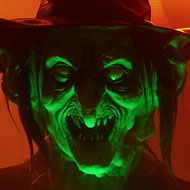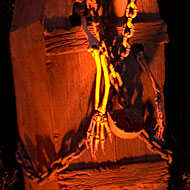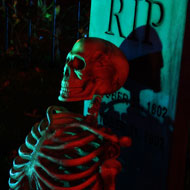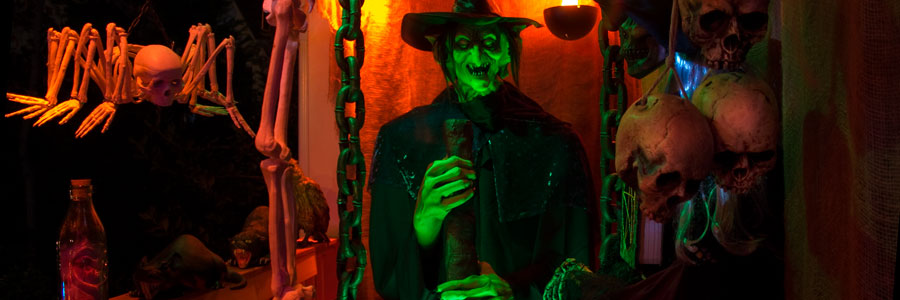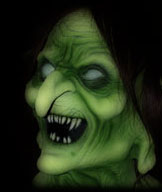Witch Stirring a Hanging Cauldron
Cauldron - Page 4
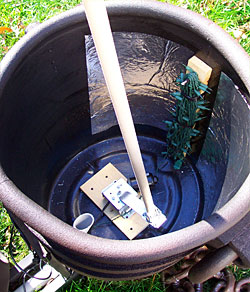 Inside the cauldron are another set of lights and the stirring mechanism.
Inside the cauldron are another set of lights and the stirring mechanism.
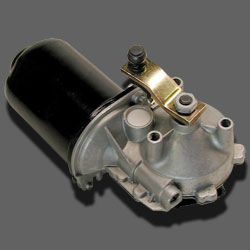 The stirrer is powered by a 12-volt DC windshield wiper motor that was purchased from www.allelectronics.com. While they no longer sell them, there are other sources for wiper motors. Monster Guts offers a new wiper motor that's very similar. I used an 8-volt, 5 amp power supply connected to the low speed terminals on the motor. This produced a speed of about 28 RPM. Scary Terry has a great web page with details about using wiper motors in prop building.
The stirrer is powered by a 12-volt DC windshield wiper motor that was purchased from www.allelectronics.com. While they no longer sell them, there are other sources for wiper motors. Monster Guts offers a new wiper motor that's very similar. I used an 8-volt, 5 amp power supply connected to the low speed terminals on the motor. This produced a speed of about 28 RPM. Scary Terry has a great web page with details about using wiper motors in prop building.
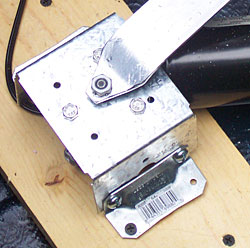 I mounted the motor with a 4x4 post cap and some angle brackets as Scary Terry described on this page. I made an arm out of some 1/8" x 2" aluminum stock which connects the motor to the stirring stick.
I mounted the motor with a 4x4 post cap and some angle brackets as Scary Terry described on this page. I made an arm out of some 1/8" x 2" aluminum stock which connects the motor to the stirring stick.
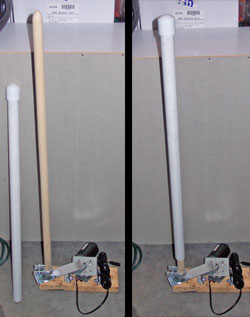 The stirring stick is made of two pieces. A 3/4" x 3' wooden dowel is attached directly to the motor arm. The end of the dowel has been sharpened to a smooth point. This point is the spin point for the stirrer. A PVC end cap is attached to a section of 1" PVC pipe that is 3 inches shorter than the dowel. When the pipe is slid down over the wooden dowel, the pipe should spin freely.
The stirring stick is made of two pieces. A 3/4" x 3' wooden dowel is attached directly to the motor arm. The end of the dowel has been sharpened to a smooth point. This point is the spin point for the stirrer. A PVC end cap is attached to a section of 1" PVC pipe that is 3 inches shorter than the dowel. When the pipe is slid down over the wooden dowel, the pipe should spin freely.
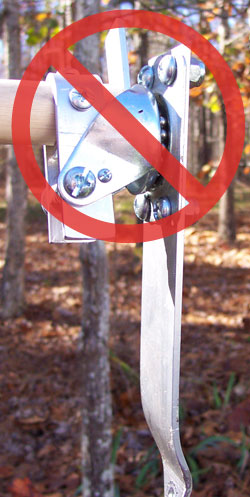 I was concerned that having the spin point at the top of the dowel might cause the stirrer to bind. So I created another spin point at the connection of the dowel and the motor arm. I used parts of a caster wheel and a homemade bracket to create the connection. However, this turned out to be completely UNNECESSARY. This additional spin point actually caused binding problems and I ended up securing that connection to keep it from spinning. It would be much better and much easier to just drill a hole thru the arm and attach the dowel directly to the arm with a long screw.
I was concerned that having the spin point at the top of the dowel might cause the stirrer to bind. So I created another spin point at the connection of the dowel and the motor arm. I used parts of a caster wheel and a homemade bracket to create the connection. However, this turned out to be completely UNNECESSARY. This additional spin point actually caused binding problems and I ended up securing that connection to keep it from spinning. It would be much better and much easier to just drill a hole thru the arm and attach the dowel directly to the arm with a long screw.
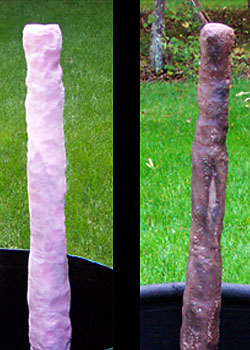 I wanted a more realistic stick than a smooth piece of pipe. So I used pink extruded foam to cover the pipe. I glued two 12"x2"
x4" rectangular pieces of foam together which formed a 12x4x4 block. Then I used a 1" bit to drill thru the long length of the glued block. I made two of these blocks and slipped them down over the PCV. I made one more 12x4x4 block but only drilled 6" into that block. I put that block over the end of the PVC and glued the three blocks together. Then I then carved and painted the foam to look like wood.
I wanted a more realistic stick than a smooth piece of pipe. So I used pink extruded foam to cover the pipe. I glued two 12"x2"
x4" rectangular pieces of foam together which formed a 12x4x4 block. Then I used a 1" bit to drill thru the long length of the glued block. I made two of these blocks and slipped them down over the PCV. I made one more 12x4x4 block but only drilled 6" into that block. I put that block over the end of the PVC and glued the three blocks together. Then I then carved and painted the foam to look like wood.
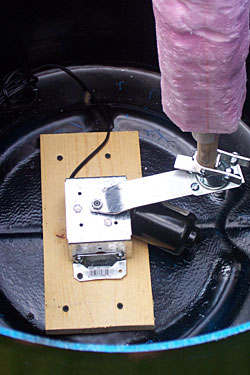 The entire stirrer mechanism was screwed thru the bottom of the cauldron into the base unit. The motor arm was bent up slightly so the top of the stir stick was moving in smaller circle than the bottom of the stick. This created a much more realistic movement in the finished prop. If you think about how a human would actually stir a large pot of liquid, the hand lower on the stick would move in a larger circle than the hand on top.
The entire stirrer mechanism was screwed thru the bottom of the cauldron into the base unit. The motor arm was bent up slightly so the top of the stir stick was moving in smaller circle than the bottom of the stick. This created a much more realistic movement in the finished prop. If you think about how a human would actually stir a large pot of liquid, the hand lower on the stick would move in a larger circle than the hand on top.
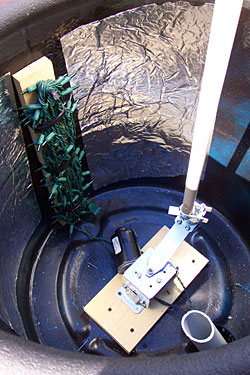 Inside the cauldron, I also added a string of green holiday lights wrapped around a couple of nails driven into a 1"x3" board cut to the depth of the cauldron. The board was secured to the side of the cauldron by two small screws driven from the outside beneath the foam bands. I used the 3M adhesive to attach two large pieces of aluminum foil to the front of the inside of the cauldron. The reflection off the foil enhanced the green glow of the lights.
Inside the cauldron, I also added a string of green holiday lights wrapped around a couple of nails driven into a 1"x3" board cut to the depth of the cauldron. The board was secured to the side of the cauldron by two small screws driven from the outside beneath the foam bands. I used the 3M adhesive to attach two large pieces of aluminum foil to the front of the inside of the cauldron. The reflection off the foil enhanced the green glow of the lights.
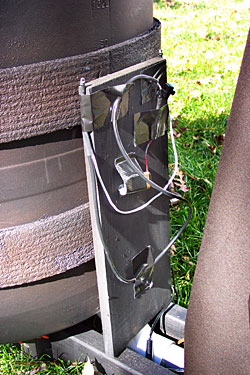 On the back of the cauldron, I attached a 1"x6" scrap piece of wood. I mounted a pair of green high intensity LED lights pointing straight up at the witch's face on the wood. This provided a nice complement to the interior lights and really illuminated the witch's face. I used black duct tape to mount the lights so they could be easily positioned.
On the back of the cauldron, I attached a 1"x6" scrap piece of wood. I mounted a pair of green high intensity LED lights pointing straight up at the witch's face on the wood. This provided a nice complement to the interior lights and really illuminated the witch's face. I used black duct tape to mount the lights so they could be easily positioned.
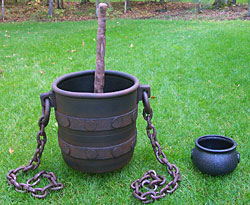 Compared to one of the "large" cauldrons sold during the Halloween season, this prop is huge.
Compared to one of the "large" cauldrons sold during the Halloween season, this prop is huge.


